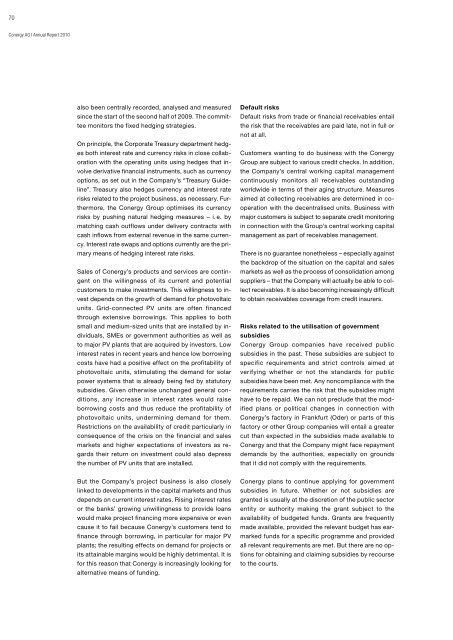from a single source. Conergy AG Annual ... - Alle jaarverslagen
from a single source. Conergy AG Annual ... - Alle jaarverslagen
from a single source. Conergy AG Annual ... - Alle jaarverslagen
You also want an ePaper? Increase the reach of your titles
YUMPU automatically turns print PDFs into web optimized ePapers that Google loves.
70<strong>Conergy</strong> <strong>AG</strong> I <strong>Annual</strong> Report 2010also been centrally recorded, analysed and measuredsince the start of the second half of 2009. The committeemonitors the fixed hedging strategies.On principle, the Corporate Treasury department hedgesboth interest rate and currency risks in close collaborationwith the operating units using hedges that involvederivative financial instruments, such as currencyoptions, as set out in the Company’s “Treasury Guideline”.Treasury also hedges currency and interest raterisks related to the project business, as necessary. Furthermore,the <strong>Conergy</strong> Group optimises its currencyrisks by pushing natural hedging measures – i. e. bymatching cash outflows under delivery contracts withcash inflows <strong>from</strong> external revenue in the same currency.Interest rate swaps and options currently are the primarymeans of hedging interest rate risks.Sales of <strong>Conergy</strong>’s products and services are contingenton the willingness of its current and potentialcustomers to make investments. This willingness to investdepends on the growth of demand for photovoltaicunits. Grid-connected PV units are often financedthrough extensive borrowings. This applies to bothsmall and medium-sized units that are installed by individuals,SMEs or government authorities as well asto major PV plants that are acquired by investors. Lowinterest rates in recent years and hence low borrowingcosts have had a positive effect on the profitability ofphotovoltaic units, stimulating the demand for solarpower systems that is already being fed by statutorysubsidies. Given otherwise unchanged general conditions,any increase in interest rates would raiseborrowing costs and thus reduce the profitability ofphotovoltaic units, undermining demand for them.Restrictions on the availability of credit particularly inconsequence of the crisis on the financial and salesmarkets and higher expectations of investors as regardstheir return on investment could also depressthe number of PV units that are installed.Default risksDefault risks <strong>from</strong> trade or financial receivables entailthe risk that the receivables are paid late, not in full ornot at all.Customers wanting to do business with the <strong>Conergy</strong>Group are subject to various credit checks. In addition,the Company’s central working capital managementcontinuously monitors all receivables outstandingworldwide in terms of their aging structure. Measuresaimed at collecting receivables are determined in cooperationwith the decentralised units. Business withmajor customers is subject to separate credit monitoringin connection with the Group’s central working capitalmanagement as part of receivables management.There is no guarantee nonetheless – especially againstthe backdrop of the situation on the capital and salesmarkets as well as the process of consolidation amongsuppliers – that the Company will actually be able to collectreceivables. It is also becoming increasingly difficultto obtain receivables coverage <strong>from</strong> credit insurers.Risks related to the utilisation of governmentsubsidies<strong>Conergy</strong> Group companies have received publicsubsidies in the past. These subsidies are subject tospecific requirements and strict controls aimed atverifying whether or not the standards for publicsubsidies have been met. Any noncompliance with therequirements carries the risk that the subsidies mighthave to be repaid. We can not preclude that the modifiedplans or political changes in connection with<strong>Conergy</strong>’s factory in Frankfurt (Oder) or parts of thisfactory or other Group companies will entail a greatercut than expected in the subsidies made available to<strong>Conergy</strong> and that the Company might face repaymentdemands by the authorities, especially on groundsthat it did not comply with the requirements.But the Company’s project business is also closelylinked to developments in the capital markets and thusdepends on current interest rates. Rising interest ratesor the banks’ growing unwillingness to provide loanswould make project financing more expensive or evencause it to fail because <strong>Conergy</strong>’s customers tend tofinance through borrowing, in particular for major PVplants; the resulting effects on demand for projects orits attainable margins would be highly detrimental. It isfor this reason that <strong>Conergy</strong> is increasingly looking foralternative means of funding.<strong>Conergy</strong> plans to continue applying for governmentsubsidies in future. Whether or not subsidies aregranted is usually at the discretion of the public sectorentity or authority making the grant subject to theavailability of budgeted funds. Grants are frequentlymade available, provided the relevant budget has earmarkedfunds for a specific programme and providedall relevant requirements are met. But there are no optionsfor obtaining and claiming subsidies by recourseto the courts.
















